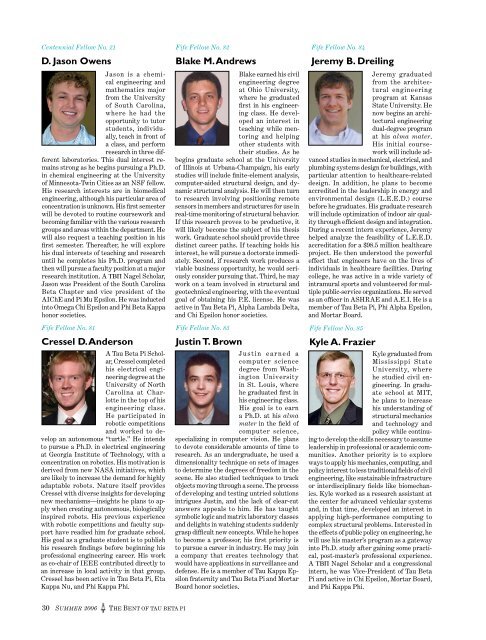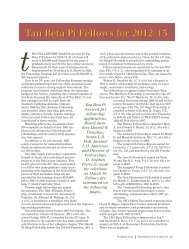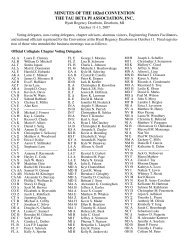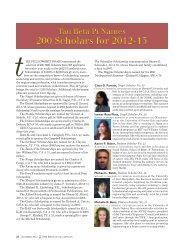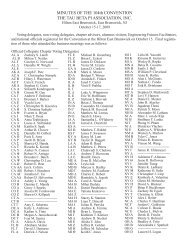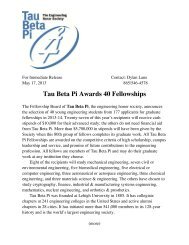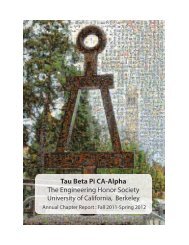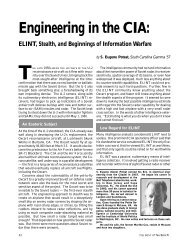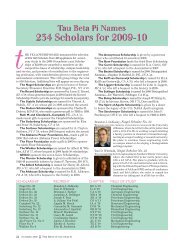D. Jason Owens Jeremy B. Dreiling Blake M. Andrews ... - Tau Beta Pi
D. Jason Owens Jeremy B. Dreiling Blake M. Andrews ... - Tau Beta Pi
D. Jason Owens Jeremy B. Dreiling Blake M. Andrews ... - Tau Beta Pi
You also want an ePaper? Increase the reach of your titles
YUMPU automatically turns print PDFs into web optimized ePapers that Google loves.
Fife Fellow No. 86Christopher A. GuidryChristopher completedthe biomedicalengineering degreeprogram at LouisianaTech University,working as a researchassistant creating artificialred blood cells.The project involvedthe encapsulation ofhemoglobin withinpolypeptide shells, but he experienced anepiphany after observing the work of anorthopedic surgeon. The difficult and preciseeffort required to perform that type ofsurgery seemed to entail as much engineeringas medicine. The benefits that patientsenjoyed as the result of successful surgeryimpressed Chris. On the strength of thisinsight, he is moving into a medical-degreetrack at the University of Texas Health Centerat San Antonio. He will undergo a twoyearimmersion in biochemistry, anatomy,histology, and pathology before spendingthe second half of his graduate education inclinical rotations in specialties. His ultimategoal is to become an orthopedic surgeon. Heis a member of Alpha Eta Mu <strong>Beta</strong> and theBiomedical Engineering Society and servedas President of the Louisiana Gamma Chapterof <strong>Tau</strong> <strong>Beta</strong> <strong>Pi</strong>.Fife Fellow No. 88Matthew L. KocoloskiA <strong>Tau</strong> <strong>Beta</strong> <strong>Pi</strong> Scholar,Matt graduatedfrom the Universityof Dayton withbachelor degrees inboth mechanical engineeringand mathematics.He plans tospend the next fewyears at CarnegieMellon Universityanalytically investigating the large-scaleimplementation of some renewable energytechnologies, with the final goal of obtaininga Ph.D. He plans to examine these technologiesfrom engineering, environmental, andeconomic perspectives, based on both thecurrent state of the art for these technologiesand the foreseeable future performanceof these types of systems. He might examinewhether recent advances in solar photovoltaictechnology will allow solar power tomeet even more of our future electricitydemands. Or he may study whether theefficiency of thermoelectric devices could allowthem to play a significant role in remotepower generation. As he works throughhis graduate program, he intends to makesignificant contributions to the engineeringcommunity. Matt is a member of <strong>Tau</strong> <strong>Beta</strong><strong>Pi</strong>, <strong>Pi</strong> <strong>Tau</strong> Sigma, and <strong>Pi</strong> Mu Epsilon.Fife Fellow No. 90Siu-Ting D. MakDickson is a civil andenvironmental engineeringgraduateof the University ofCalifornia, Berkeley.A professor’s presentationignited hisinterest in bridgestructures and inspiredhim to beginan independent undergraduateresearch project on self-anchoredsuspension bridges. He plans toobtain a one-year master’s degree and willevaluate his options as the work progresses.He hopes to become a leading engineer inthe area of innovative bridge structuraldesign. His ambition is to build bridges thatconnect Hong Kong, his home city, with theneighboring Zhujiang River delta in China.The bridges he envisions would architecturallyfit into the natural scenery and be environmentallyfriendly during construction.Dickson’s undergraduate work as a physicsstudent and tutor helped to reinforce hisinterest in teaching. He is a member of theAmerican Society of Civil Engineers and hasbeen an active chamber musician on campus.He is the historian for the on-campus societyof Hong Kong and Chinese affairs.Fife Fellow No. 87Joseph A. HarperTony is a computerengineering graduateof the Universityof Louisville’s SpeedSchool of Engineering.A former co-opstudent, he plans tostudy computer scienceand computerengineering in thegraduate programat U.L. His particular areas of interestinclude internet applications and internetframeworks because technology and marketforces appear to be heading in those directions.During graduate school, he plans toexplore hypertext and multimedia, internetapplication design and development, datamining, and advanced databases/data warehousing.He hopes to combine this courseworkwith a project that would benefit thecommunity. For example, he might helplocal transit customers navigate among theroughly 100 bus lines throughout Louisville.Information about each individual bus routeis freely available; however, Tony envisionsweb-based software that would help riderstransfer between routes. Tony’s professorspraised his dedication to rigorous academicwork and his good-natured rapport withothers. He is a member of ACM.Fife Fellow No. 89Francis D. Lagor Jr.Frank graduatedfrom Villanova Universitywith a degreein mechanicalengineering. Teachingand researchdominate his plans ashe begins graduatestudies at the Universityof Pennsylvania.While servingas an undergraduate tutor, he experiencedthe steep challenges and breakthroughsinvolved in teaching others. This inspiredhim to work toward joining the faculty ata top engineering school. To prepare, herecognizes the need to perform extensiveresearch and coursework. As a lab assistant,he studied fluid mechanics as applied to themovement of insulation debris in the emergencycore cooling system of a pressurizedwater reactor. He learned to combine heattransfer and fluid mechanics during independentresearch. To develop his teaching andresearch skills fully, he expects to pursue aPh.D. in mechanical engineering. A memberof <strong>Tau</strong> <strong>Beta</strong> <strong>Pi</strong>, <strong>Pi</strong> <strong>Tau</strong> Sigma, and PhiKappa Phi honor societies, Frank tutoredextensively, played intramural basketballand baseball, and founded an all-male acappella group.Fife Fellow No. 91Evan R. NealEvan earned hisB.S.E.E. from theUniversity of Utah,graduating first inhis engineering class.He plans to obtainboth a master’s degreeand a Ph.D. inelectrical engineeringat Stanford University,followed bya research professorship in academia.He has direct experience with those whosuffer disorders such as schizophrenia, bipolardisorder, heart disease, deafness, andblindness. His intimate knowledge of theseillnesses triggered his interest in findingways that electronic instruments might mediateanomalies in various human systems.A principle challenge is developing efficientinstruments for measuring and interpretingthe brain’s signals, because current instrumentsare inefficient, large, and consumeconsiderable power. Evan hopes to workon the development of a small, low-powerchip that can operate on the same level asthe instruments currently being used. Hehas volunteered in a retirement center andhomeless clothing drive. A TBP Scholar, hewas Vice President of the Utah Alpha Chapterand is a member of Phi Kappa Phi.SUMMER 2006THE BENT OF TAU BETA PI31
Fife Fellow No. 92Michael D. SadowitzMike is a graduateof the electrical engineeringprogramat the University ofNevada, Las Vegas,where he plans topursue his graduatestudies with anemphasis on solidstatematerials anddevices. His thesistopic involves the modeling, simulation, andfabrication of sub-100 nm solid-state devices.He hopes to augment his research withnon-engineering coursework, including anintroductory Chinese language course. Withan NSF summer research grant at UNLV,he not only worked in the nanotechnologylaboratory, but also helped to constructit. He was involved in the installation andmaintenance of a field-emission scanningelectron microscope, nanocluster depositionmachine, and a laboratory electromagnet.He conducted experiments and published apaper at the 2005 American Nuclear Societyconference. He helped start a high-schooloutreach program and volunteered withHabitat for Humanity and Meals on Wheels.A TBP Scholar and President of the Nevada<strong>Beta</strong> Chapter, Mike is a member of theIEEE and Phi Kappa Phi.King Fellow No. 45Rachel S. MarulloRachel is a graduateof NortheasternUniversity’s chemica l e n g i n e e r i n gprogram. She willbegin her master’sprogram at the Universityof California,Santa Barbara. Afterexploring and theneliminating manufacturingas an interest, Rachel settled on performingresearch and contributing to newfindings. This interest grew as she attendedfour conferences of the American Instituteof Chemical Engineers and reviewed theresearch presentations. A subsequent jobdealing with industrial fabrics and coatingswith Albany International ResearchCompany sparked her interest in polymerscience. Her interest eventually turned toapplications in biological engineering. Shecoupled that with her fondness of fluid dynamicsand mass transfer and began reviewingcurrent articles about drug delivery.She is a member of <strong>Tau</strong> <strong>Beta</strong> <strong>Pi</strong> and wasthe president of her American Institute ofChemical Engineers chapter; her group wonback-to-back outstanding chapter awards,and she was heavily involved in planning andexecuting its regional conference.Stark Fellow No. 29Michael S. McDonaldM i k e g r a d u a t e dfrom the Universityof Michigan with adual degree in aerospaceengineeringand engineeringphysics. He will enteran aerospace engineeringdoctoralprogram at his almamater, where he willspecialize in propulsion systems like theHall thruster and plasma physics. He wasintrigued to learn that an advanced electricpropulsionsystem weighing as much as aloaf of bread could carry the same payloadto Jupiter as a chemical rocket weighing thesame as a 747 jumbo jet. He signed up fornon-required courses in gas kinetic theoryand the physics of electric propulsion toprepare himself for his thesis researchon Hall thrusters. These connect severalthrusters in parallel to increase drive forcewithout increasing power input per thruster.Mike gained experience working on sensitivefluid-flow devices while working as anintern. He was an active tutor in college andvolunteered in science-related programsworking with elementary-school students.He plays soccer, hockey, and intramuralbroomball.Spencer Fellow No. 51<strong>Jason</strong> J. Hallman<strong>Jason</strong> is a mechanicalengineering graduateof Valparaiso University.His research interestscenter aroundthe biomechanics ofhuman motion aswell as quantitativeanalysis of humaninjury. Eventually, hewould like to becomea researcher in automotive safety and accidentreconstruction. Obtaining professionalengineering licensure and earning a Ph.D.are important elements of his plans. He isbeginning his master’s work at MarquetteUniversity, one of the few injury-biomechanicsfacilities in the nation. He first becameinterested in biomechanics through co-opwork at Biomet Orthopedics, a sponsor hesought to ensure that his engineering workwould directly benefit the lives of others.There, he gained experience in experimentalengineering as applied to the kinetics ofhuman articulations. As an undergraduate,he served on the honors council and enjoyeda variety of music-related pursuits. A TBPScholar, <strong>Jason</strong> is a member of the Society ofAutomotive Engineers and the ASME andserved as the President of <strong>Tau</strong> <strong>Beta</strong> <strong>Pi</strong>’sIndiana Delta Chapter.Sigma <strong>Tau</strong> Fellow No. 33Jennifer A. PazourJen graduated withan industrial engineeringdegree fromthe South DakotaSchool of Mines andTechnology. She willattend graduateschool at the Universityof Arkansas,Fayetteville, and,work toward a Ph.D.in industrial engineering. She will pursueinternships at larger companies to gainfamiliarity with their logistics systems.Of particular interest to her is the area ofoperations research, which allows her toapply mathematic and engineering conceptsto solve complex, real-world problems. Jenplans on studying linear programming,production planning, and optimizationtheory. Then, she hopes to combine academicresearch with industry trends to createmathematical models that would apply inone or more specific industries. Eventually,she intends to teach at the college level. Shewas an officer in the Institute of IndustrialEngineers, Student Association, and theStudent Alumni Connection, as well as seniorclass president and homecoming queen.A TBP Scholar, she is a member of Phi EtaSigma, Alpha <strong>Pi</strong> Mu, and SWE.Williams Fellow No. 27Marissa A. MiracoloMarissa graduatedfrom the CooperUnion School of Engineering.Havingcompleted her mechanicalengineeringdegree there, she willenter the graduateprogram at CarnegieMellon University.She anticipates thatthe world will transition to sustainable energysources such as solar-energy generation,and she aims to develop coursework and leadresearch toward this goal. Her senior-thesisproject focused on combining photovoltaicenergy generation and solar thermal waterheating. After obtaining her doctoraldegree, she plans to conduct research andteach at the university level. She wants tohelp reduce pollution and utilize waste energyin order to minimize the environmentalimpact of engineering systems. As presidentof the New York Iota Chapter of <strong>Tau</strong> <strong>Beta</strong><strong>Pi</strong>, she co-founded a volunteer peer-to-peertutoring service on campus. Encouragingwomen to enter a career in engineeringis an ongoing interest for her. Marissa is amember of <strong>Pi</strong> <strong>Tau</strong> Sigma, ASME, and SWEand served as vice president of a Habitat forHumanity club.32 SUMMER 2006 THE BENT OF TAU BETA PI
Deuchler Fellow No. 27Jasmine R. GaljourJasmine has receiveda civil engineeringdegree from theUniversity of Louisianaat Lafayette.H e r i m m e d i a t eplans include beginninggraduate workat the University ofTexas at Austin witha concentration inenvironmental engineering. Her specificinterest is in the treatment of contaminatedsoil, air, groundwater, or hazardous waste.She plans to deepen her knowledge throughresearch and coursework before becominginvolved in a more intensive, ground-breakingresearch project. Her goal is to earn aPh.D. in environmental engineering andbecome a professional civil engineer, eitherat a university or a private company. <strong>Tau</strong><strong>Beta</strong> <strong>Pi</strong> Record Scholar No. 91, Jasmine wasPresident of <strong>Tau</strong> <strong>Beta</strong> <strong>Pi</strong>’s Louisiana DeltaChapter, the Society of Women Engineers,and the Louisiana Engineering Society. Sheheld offices in Chi Epsilon and the ASCE.She organized and directed volunteer effortsto paint, clean, and landscape theengineering building and actively supporteda safer campus for all.Nagel Fellow No. 9David C. Gomez<strong>Tau</strong> <strong>Beta</strong> <strong>Pi</strong> NagelScholar No. 18, Davidis a graduate of thepetroleum engineeringprogram at theUniversity of Louisianaat Lafayette.His graduate workat his alma materwill focus on drillingengineering. Hisresearch and development will be on thetopic of using heavy foam as a drilling fluidin deep-water drilling. As petroleum drillingmoves to waters exceeding 1,000 feetin depth, there is increasing demand fortechnologies that are well-suited for hightemperature,low-formation fracture gradients,and especially high pressure. David’sresearch/development goal is to formulate adeep-water drilling fluid in the form of heavyfoam. An internship at Stone Energy solidifiedhis decision to become an operations /well-planning drilling engineer. He is a memberof <strong>Tau</strong> <strong>Beta</strong> <strong>Pi</strong>, <strong>Pi</strong> Epsilon <strong>Tau</strong>, LouisianaEngineering Society, Student Society ofPetroleum Engineers, Latin America StudentAssociation, and the American Societyof Petroleum Engineers.Anderson Fellow No. 2Michelle L. BashMichelle received herB.S.E.E. from OhioNorthern University.Her co-op work atAmerican ElectricPower became oneof her most formativeand challengingcollege experiences—troubleshootingequipment orschemes that were not working. Thesereal-world experiences tested both herengineering skills and her critical-thinkingabilities. During her schoolwork shediscovered another application for heranalytical skills; computer programming,which she adopted as a minor. She plans toattend Purdue University and pursue anM.S.E.E., with a concentration in powerelectronics, and doctoral studies. To prepareherself, she participated in a NASA-sponsoredsenior-design project that involvesan electronic system to power and control adisplay. President of the Ohio Iota Chapterof <strong>Tau</strong> <strong>Beta</strong> <strong>Pi</strong>, Michelle received the ECCSKingenberger scholarship two times. Shewas involved with Habitat for Humanityduring five successive years.Matthews Fellow No. 9Lisa J. LindquistLisa graduated fromthe civil engineeringprogram at OhioNorthern University.She will pursue anM.S.C.E. in the structuralengineering andmechanics disciplineat the Georgia Instituteof Technologywith expectation ofextending into a Ph.D. program. Her aimis to aid design of a reliable infrastructuresystem using available resources effectivelyin developing countries. She tailored herundergraduate education to complete aSpanish major, including study abroad inGunajuato, Mexico. Through organizationssuch as Engineers Without Borders, shehopes to gain practical international experience.As a senior, she helped the OhioDepartment of Transportation in designinga bridge to replace one that was functionallyobsolete. Her experiences solidifiedher interest in structural engineering. Hervolunteer activities included ONU Circle KClub, relay for life, and Habitat for Humanity.A member of <strong>Tau</strong> <strong>Beta</strong> <strong>Pi</strong>, Mortar Board,Phi Kappa Phi, and the ASCE, Lisa was onthe varsity track and field team throughoutcollege.Astronaut Fellow No. 6Justin L.R. LangloisJustin studied aerospaceengineeringat the United StatesNaval Academy,graduating at the topof his class. Duringhis senior year, he didresearch involvinga dynamic computermodel of a space powersystem consistingof a nuclear reactor and Stirling powerconverters. The reactor portion involvedworking with naval reactors in departmentof energy converters, and the Stirling powerconverters involved NASA. He is convincedthat nuclear energy is the next step requiredto increase the capability of space explorationand provide greater returns on spaceinvestments. In graduate school at theUniversity of Michigan, he would like tocontinue research in the dynamic modelingof space power or space-propulsion systemsfor the purpose of deep-space exploration.He hopes to become a Navy SEAL, wherehis technical background and leadership experiencescan be put to good use. A memberof <strong>Tau</strong> <strong>Beta</strong> <strong>Pi</strong> and Phi Kappa Phi, Justinserved as a regimental commander in chargeof approximately 2,000 midshipmen.<strong>Tau</strong> <strong>Beta</strong> <strong>Pi</strong> Fellow No. 734Tondra DeTondra earned bachelor’sdegrees in electricalengineeringand in mathematicsat the University ofNevada, Las Vegas.Her greatest interestlies in making theteaching and learningof science, technology,engineering,and math more effective and inclusive. Asan undergraduate, she undertook numerousextracurricular research activities,including NSF-funded summer work. Shetaught an honors freshman class as wellas ethnographic studies. She completed atwo-year summer internship performingstatistical analysis and survey research atBechtel-SAIC. In her doctoral program atthe University of California, Los Angeles,Tondra will study the design of learningtechnologies that aid learning amongunderrepresented groups in engineering.Advanced coursework will prepare her fora dissertation in web-based learning. Sheis a member of <strong>Tau</strong> <strong>Beta</strong> <strong>Pi</strong>, Phi KappaPhi, Phi Eta Sigma, the Society of WomenEngineers, and the Institute of Electricaland Electronics Engineers. She receivedan NSF fellowship.SUMMER 2006THE BENT OF TAU BETA PI33
<strong>Tau</strong> <strong>Beta</strong> <strong>Pi</strong> Fellow No. 735Amit Y. DesaiAmit is a materialsscience and engineeringgraduate ofNorth Carolina StateUniversity, where hegraduated first in hisentire class. He viewsa master’s degreein materials scienceas a necessary steptoward reaching aposition of meaningful leadership within hisfield and will attend Cambridge Universitythis fall. In college, he participated in twosummer research experiences. At Northwestern,he gained experience with cutting-edgeanalytical instrumentations andwitnessed the ingenuity required to modifythat equipment to suit special situations. Hewas one of 15 undergraduates selected bythe NSF to participate in ongoing researchat MIT. There, he investigated the potentialuse of titanium nitride as an adhesion layerand diffusion barrier in thin film ceramics.Amit is a volleyball player and performed inthe Raleigh Civic Symphony as a violinist. Amember of <strong>Tau</strong> <strong>Beta</strong> <strong>Pi</strong> and Phi Kappa Phi,he also won a congressionally funded BarryM. Goldwater scholarship.<strong>Tau</strong> <strong>Beta</strong> <strong>Pi</strong> Fellow No. 737Hoda M. EydgahiH o d a g r a d u a t e dfrom Virginia CommonwealthUniversitywith a bachelor’sdegree in biomedicalengineering. Sheplans to pursue anM.S.E.E. at MIT andto obtain her Ph.D.s o o n t h e r e a f t e r.Through this plan,she will fulfill her goal of entering academiaas a university professor and conductresearch in the field of engineering withapplications in medicine. She views professorshipas an opportunity to both teach andlearn from her future students. In school,she developed an interest in medicine, signalprocessing, instrumentation, and robotics.Hoda would like to work on interdisciplinaryprojects such as smart instruments tobe used in surgery or devices used to benefitthe deaf. She has conducted research concerningthe knockdown of the Werner Syndromeprotein using a lentiviral system andpresented the results at six symposiums.Active in <strong>Tau</strong> <strong>Beta</strong> <strong>Pi</strong>, Phi Kappa Phi, andthe Biomedical Engineering Society, shehas volunteered for a variety of tasks atPeninsula Regional Medical Center.<strong>Tau</strong> <strong>Beta</strong> <strong>Pi</strong> Fellow No. 739Rachel L. HusfeldRachel completedher B.S.C.E. at ValparaisoUniversity.As a graduate studentat Texas A&MUniversity, she willpursue an M.S.C.E.with a specializationin structural engineering.She will investigatemethodsfor minimizing displacements and accelerationsthat act upon concrete and brick lowincomehousing units during earthquakesin Chile. She hopes to counteract lowerintensity structural motions that can causenausea among building occupants. She willperform numerical simulations and plansto test laboratory models on a shake tableat the University of Chile. She hopes toobtain funding from the Chilean Ministryof Housing for the construction of full-sizeexperimental buildings. She was presidentof her Engineers Without Borders chapterand helped lead a three-year clean-waterinitiative in Nakor, Kenya. Named to theUSA Today 2005 college academic all-starfirst team and a member of the ASCE andSWE, Rachel was inducted into <strong>Tau</strong> <strong>Beta</strong> <strong>Pi</strong>and Alpha Lambda Delta.<strong>Tau</strong> <strong>Beta</strong> <strong>Pi</strong> Fellow No. 736Ryan G. DobieRyan graduated fromthe U.S. Naval Academywith a degree inmechanical engineeringand a Spanishminor. He will pursuea graduate degreeat the University ofPennsylvania. Hisgoal is to become anintelligence officerin the U.S. Navy, a position not availabledirectly from the academy. The ability to enterthis field is based upon experience. Thefield requires applying analytical skills tointelligence information in situations where“learning by experience” often means riskinglives. Faced with this responsibility,Ryan will study how to analyze situations,minimize risks, maximize success, andensure that he upholds the trust that isplaced in him. Through studies in operationsresearch, he intends to acquire the skillsnecessary to make real-time decisions withouthesitation and to gain the confidence ofthose with whom he serves. He commanded600 midshipmen and was given the responsibilityof investigating honor violations inhis senior year. An academic all-Americanmember of the club-sport hockey team,he was a member of Phi Sigma Iota andVice President of <strong>Tau</strong> <strong>Beta</strong> <strong>Pi</strong>’s MarylandGamma Chapter.<strong>Tau</strong> <strong>Beta</strong> <strong>Pi</strong> Fellow No. 738David L. HenannDavid graduatedfrom State Universityof New York atBinghamton with adegree in mechanicalengineering. Hewill attend graduateschool at MIT wherehe will concentrateon nanotechnologyrelated to mechanicalengineering. His ultimate goal is to do doctoraland post-doctoral work before joiningan engineering faculty. His current interestsare in nanotechnology, mechanical behaviorof materials, and computational mechanics.He gained a background in these subjectsafter undergraduate work in areas suchas solid mechanics, continuum mechanics,computational methods, and finite-elementanalysis. His research interest lies innanomechanics and nanomechanical testingwhich he experienced while at the NationalInstitute of Standards and Technology. Heplans to develop and design a novel mechanicaltesting method for nano-scale materialsand structures, because these pose specialproblems compared with conventionalmaterials testing. David was a member ofthe university wind ensemble, orchestra,and brass quintet. He is a member of <strong>Tau</strong><strong>Beta</strong> <strong>Pi</strong>, Phi Eta Sigma, and <strong>Pi</strong> <strong>Tau</strong> Sigmahonor societies.<strong>Tau</strong> <strong>Beta</strong> <strong>Pi</strong> Fellow No. 740Krenar KomoniKrenar graduatedfrom Norwich Universitywith bachelor’sdegrees in computerengineeringand mathematics. Atage six, he wantedto know all aboutthe smallest circuitcomponents inside acomputer, and, today,that fascination has not changed. That lifelongcuriosity about computer engineering,mathematics, and computer science has preparedhim for graduate-level studies at TuftsUniversity. He hopes someday to design energyefficient and adaptive radio-frequencyintegrated circuits for various wirelessapplications, develop higher-performanceprocessors, or improve simulation and modelingtechniques for integrated circuits. Hisultimate goal is to succeed as an entrepreneurand still contribute to academia in someway. During college, he worked on a projectfunded by the National Security Agencyand later worked as a systems engineer forBitWave Semiconductor, Inc. Krenar wasPresident of the Vermont <strong>Beta</strong> Chapter of<strong>Tau</strong> <strong>Beta</strong> <strong>Pi</strong> and is a member of IEEE andEta Kappa Nu. He developed and updateda website for Direct Aid International, anonprofit group that builds schools, wells,and libraries in Afghanistan.34 SUMMER 2006 THE BENT OF TAU BETA PI
<strong>Tau</strong> <strong>Beta</strong> <strong>Pi</strong> Fellow No. 741Matthew R.Y. LohMatthew holds abachelor’s degree inelectrical engineeringfrom LafayetteCollege. His goal is toperform cutting-edgeresearch in the areasof high-frequencyradio-frequency andoptical-interconnectdesign, and he plansto pursue a Ph.D. at Columbia University.After foundational coursework, he will becomeinvolved in research work. Duringhis undergraduate work, he discovereda passion for analog integrated-circuitdesign. He designed a Gilbert-cell analogmultiplier using a low-cost BiCMOS process,which was later presented at the NationalConference for Undergraduate Research.During his senior year, Matthew designeda successive-approximation, bipolar 8-bitA/D converter based on a hybrid chargescaling/resistor-stringD/A technique. Heserved as a research assistant for a projectin circulatory system modeling, which led toan undergraduate thesis and presentation atseveral national conferences. He is a memberof IEEE, the Biomedical EngineeringSociety, <strong>Tau</strong> <strong>Beta</strong> <strong>Pi</strong>, and <strong>Pi</strong> Mu Epsilon.<strong>Tau</strong> <strong>Beta</strong> <strong>Pi</strong> Fellow No. 743S. Farshid Moussavia-HaramiFarshid graduatedfrom the Universityof Iowa with abachelor’s degree inbiomedical engineering.He has been acceptedinto the M.S.fast-track programin the department ofbiomedical engineeringat his school. Thegoal of his master’s project is the developmentof imaging tools for the automation ofMankin analysis, which is a semi-quantitativemethod used to analyze osteoarthritisseverity in cartilage histological sections.Upon completion of his master’s studies, hehopes to continue his graduate work in thefield of biomedical imaging and cell biology.For three years, he has been conductingresearch in the department of orthopaedicsurgery and rehabilitation cell biologylaboratory. Results of his research werepublished in the Iowa Orthopaedic Journaland presented at the annual OrthopaedicResearch Society meeting. Farshid wasthe Treasurer of <strong>Tau</strong> <strong>Beta</strong> <strong>Pi</strong>’s Iowa <strong>Beta</strong>Chapter and president of the Persian StudentOrganization. He was a <strong>Tau</strong> <strong>Beta</strong> <strong>Pi</strong>Record Scholar in 2005.<strong>Tau</strong> <strong>Beta</strong> <strong>Pi</strong> Fellow No. 745Himani SuhagHimani obtained herelectrical, computer,and systems engineeringdegree atRensselaer PolytechnicInstitute, finishingfirst in her class.She was involved inthe CenSSIS scholarsprogram, the honorseminarprogram,and the undergraduate research program,held at the Pennsylvania State University.She plans to earn her master’s and Ph.D.degrees in nanoelectronics at the Universityof Albany. In preparation, she interned withIBM’s microelectronics division, where shewas introduced to numerous industry-basedtools and explored the stages of productdevelopment. Her interest in microelectronicsand nanoelectronics were deepened, as aresult. She perceives growing opportunitiesin nanotechnology, particularly in the area ofnanoelectronics. Himani has been recognizedfor her work in the Society of Women Engineersand worked extensively in the campusmentor program for women. A member of<strong>Tau</strong> <strong>Beta</strong> <strong>Pi</strong> and Eta Kappa Nu, she donated40 inches of her hair to Locks of Love.<strong>Tau</strong> <strong>Beta</strong> <strong>Pi</strong> Fellow No. 742Jessy J. MoinnesJessy received abachelor’s degree inbioengineering fromthe University ofIllinois at Chicagoand plans to attendgraduate school atNorthwestern University.Her goal isto complete a Ph.D.,become a highly qualifiedresearch engineer, and develop newmagnetic resonance imaging (MRI) scannersfor a large company such as Siemensor General Electric. As an undergraduate,she performed research into stimulatingthe growth of tissue-engineered bone withultrasound and monitoring the process usingMRI. She gained experience using the highfield(11.75 T) Bruker magnet to image smallbiological samples and determine differentparameters characterizing biological tissues.She co-authored a paper on research into themapping of magnetic resonance parametersfor different stages of diseased articularcartilage. Jessy spent two semesters designing,fabricating, testing, and implementingan artifact-suppression electronic circuit tobe part of an electrophysiology station. Sheis a member of the International Society forPharmaceutical Engineering, the Society ofWomen Engineers, and the International Societyfor Magnetic Resonance in Medicine.<strong>Tau</strong> <strong>Beta</strong> <strong>Pi</strong> Fellow No. 744Geoffrey M. OxberryGeoffrey is a chemica l e n g i n e e r i n ggraduate of the Universityof Delaware.He plans to attendgraduate school atMIT, specializingin systems biology.Having establisheda strong chemistryfoundation at college,he is interested in quantifying the behaviorof the human body for the purpose of findingeffective treatments for chronic illnesses.By modeling the underlying biochemistry ofan illness, he hopes to develop a microfluidicdevice that can personalize the treatmentof the illness. His coursework will includequantitative subjects such as molecular biology,genetics, and advanced biochemistry.He will also take such courses as computationalsystems biology, bioinformatics, andcomputational genomics. Ideally, all of thecoursework would culminate in a doctoraldissertation on the modeling and effectivemanagement of chronic disease. Beyondthat, his broad goal is to develop a devicethat will maximize therapeutic treatmentand minimize harmful side effects. Geoffis a member of <strong>Tau</strong> <strong>Beta</strong> <strong>Pi</strong> and Phi KappaPhi honor societies, enjoys extracurricularactivities, and has received numerous academicawards and honors.PLANNED GIVING<strong>Tau</strong> <strong>Beta</strong> <strong>Pi</strong>’s updated 26-pageguide to planned-giving opportunitiesshows how your support canbenefit both our Association andyour financial situation.Topics include:• Gifts of cash, stock, real estate,and life insurance,• Charitable lead trusts, and• Charitable remainder trusts.To obtain a copy, please email:GivingBooklet@tbp.org or write:<strong>Tau</strong> <strong>Beta</strong> <strong>Pi</strong>, P.O. Box 2697, Knoxville,TN 37901-2697.<strong>Tau</strong> <strong>Beta</strong> <strong>Pi</strong> is classified as aneducational not-for-profit corporationunder Section 501(c) (3) (notprivate) of the U.S. Internal RevenueCode.The proper form of a bequestis: “I give, devise, and bequeath toThe <strong>Tau</strong> <strong>Beta</strong> <strong>Pi</strong> Association, Inc.,a corporation existing under andby virtue of a charter granted bythe State of Tennessee and withits Headquarters in the City ofKnoxville, in said state, $ . . . (or,the following described property, orsecurities).”SUMMER 2006THE BENT OF TAU BETA PI35


